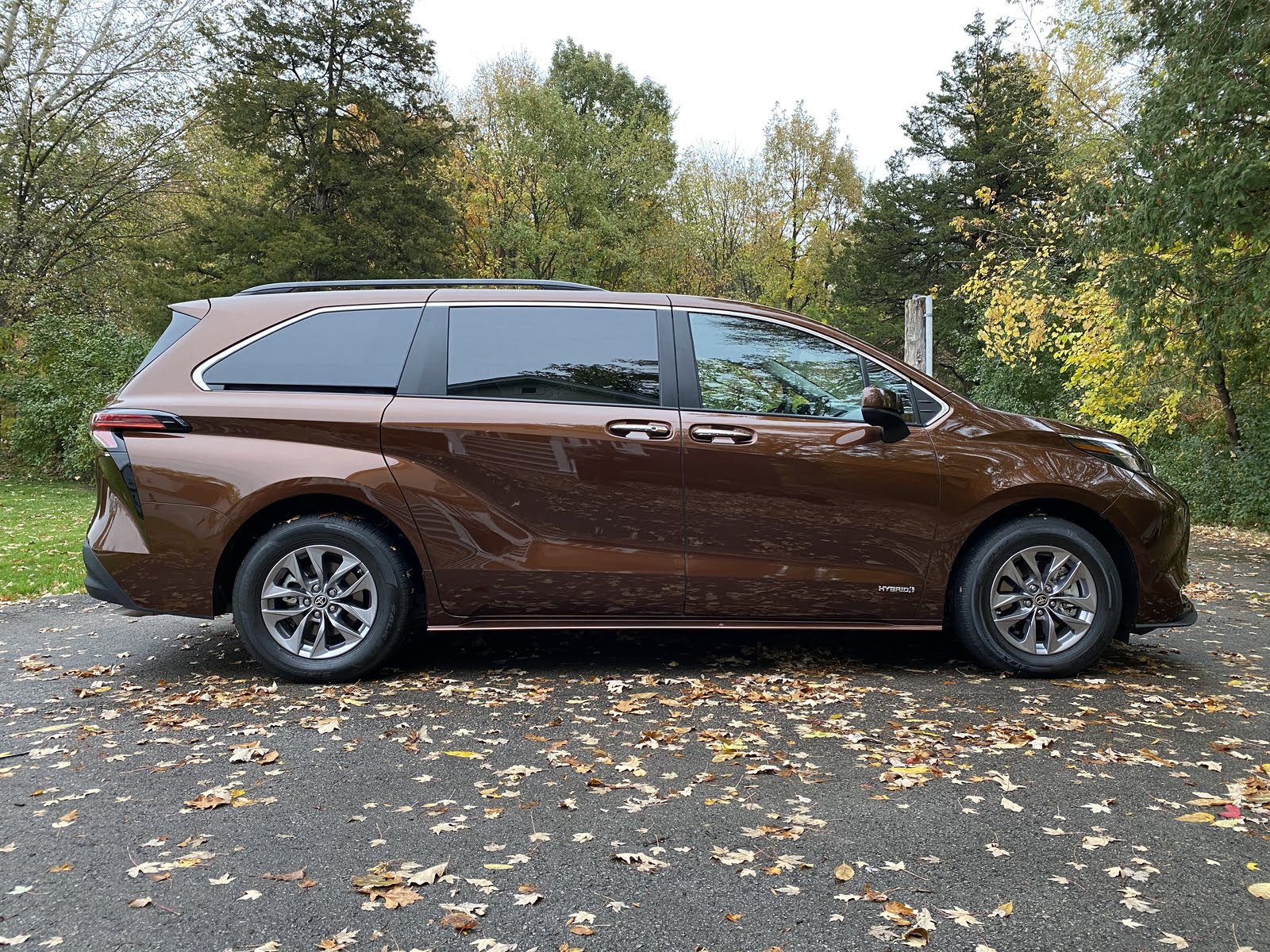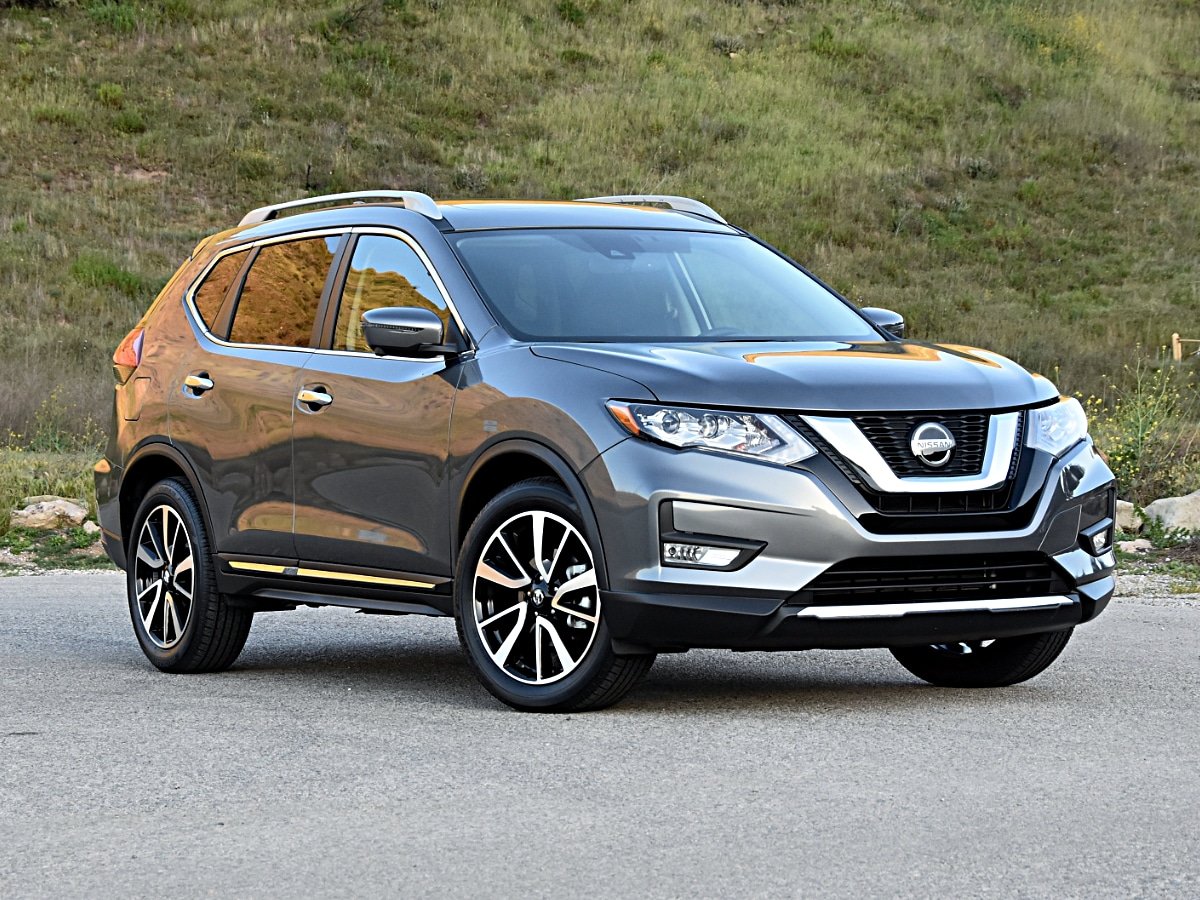2021 Toyota Sienna vs 2020 Nissan Rogue
Overview | |
MSRP$25,490 | MSRP$34,460 |
Listings1166 | Listings688 |
Ratings & Reviews | |
User Reviews | User Reviews |
Expert reviews6.0 out of 10 | Expert reviews8.3 out of 10 |
Pros
Cons
| Pros
Cons
|
2020 Nissan Rogue Reviews SummaryNissan hasn’t redesigned the Rogue since 2014, but an all-new version of this SUV is coming for the 2021 model year. In the meantime, dealers will be eager to sell remaining stocks of the outgoing 2020 Nissan Rogue, and the deals on these new cars ought to be mighty juicy. Should you bite? Should you wait? Or should you shop for something else? The answers to these questions depend on who you are and what you value in a compact crossover SUV. | |
2021 Toyota Sienna Reviews SummaryToyota’s minivan got a major makeover for 2021, now entering its fourth generation of production since debuting as a 1997 model. For the first time, the Sienna gets a hybrid gasoline-electric powertrain, and not only that—it’s standard equipment. The Sienna Hybrid is built on the Toyota New Global Architecture (TNGA-K) platform, shared with the Highlander and other current Toyota models. | |
No video found | |
Popular Features & Specs | |
Engine2.5L 170 hp I4 | Engine2.5L 245 hp I4 Hybrid |
Drive TrainFWD | Drive TrainFWD |
Seating Capacity5 | Seating Capacity8 |
Horsepower170 hp @ 6000 rpm | Horsepower |
EV Battery Capacity | EV Battery Capacity1.9 kWh |
MPG City26 | MPG City36 |
MPG Highway33 | MPG Highway36 |
Engine | |
Engine Name2.5L 170 hp I4 | Engine Name2.5L 245 hp I4 Hybrid |
Torque175 lb-ft @ 4400 rpm | Torque |
Horsepower170 hp @ 6000 rpm | Horsepower |
DrivetrainFWD | DrivetrainFWD |
Fuel Economy | |
EV Battery Capacity | EV Battery Capacity1.9 kWh |
MPG City26 | MPG City36 |
MPG Highway33 | MPG Highway36 |
Interior | |
Seating Capacity5 | Seating Capacity8 |
Safety | |
Front Crash Overall4 | Front Crash Overall4 |
Side Crash Overall5 | Side Crash Overall5 |
Dimensions & Capacity | |
Cargo Space39.3 cu ft | Cargo Space33.5 cu ft |
Curb Weight3463 lbs | Curb Weight4610 lbs |
Height66.3 in | Height68.5 in |
Length184.5 in | Length203.7 in |
Width72.4 in | Width78.5 in |
Wheelbase106.5 in | Wheelbase120.5 in |
Maximum Payload1127 lbs | Maximum Payload1560 lbs |
Number of doors4 | Number of doors4 |
Maximum Towing Capacity | Maximum Towing Capacity3500 lbs |
Overview | ||
MSRP | $25,490 | $34,460 |
Listings | ||
Ratings & Reviews | ||
User reviews | ||
Expert reviews | 6.0 out of 10Read full review | 8.3 out of 10Read full review |
Pros & cons | Pros
Cons
| Pros
Cons
|
Summary | Nissan hasn’t redesigned the Rogue since 2014, but an all-new version of this SUV is coming for the 2021 model year. In the meantime, dealers will be eager to sell remaining stocks of the outgoing 2020 Nissan Rogue, and the deals on these new cars ought to be mighty juicy. Should you bite? Should you wait? Or should you shop for something else? The answers to these questions depend on who you are and what you value in a compact crossover SUV. | Toyota’s minivan got a major makeover for 2021, now entering its fourth generation of production since debuting as a 1997 model. For the first time, the Sienna gets a hybrid gasoline-electric powertrain, and not only that—it’s standard equipment. The Sienna Hybrid is built on the Toyota New Global Architecture (TNGA-K) platform, shared with the Highlander and other current Toyota models. |
Video | No video found | |
Popular Features & Specs | ||
Engine | 2.5L 170 hp I4 | 2.5L 245 hp I4 Hybrid |
Drive Train | FWD | FWD |
Seating Capacity | 5 | 8 |
Horsepower | 170 hp @ 6000 rpm | |
EV Battery Capacity | 1.9 kWh | |
MPG City | 26 | 36 |
MPG Highway | 33 | 36 |
Engine | ||
Engine Name | 2.5L 170 hp I4 | 2.5L 245 hp I4 Hybrid |
Torque | 175 lb-ft @ 4400 rpm | |
Horsepower | 170 hp @ 6000 rpm | |
Drivetrain | FWD | FWD |
Fuel Economy | ||
EV Battery Capacity | 1.9 kWh | |
MPG City | 26 | 36 |
MPG Highway | 33 | 36 |
Interior | ||
Seating Capacity | 5 | 8 |
Safety | ||
Front Crash Overall | 4 | 4 |
Side Crash Overall | 5 | 5 |
Dimensions & Capacity | ||
Cargo Space | 39.3 cu ft | 33.5 cu ft |
Curb Weight | 3463 lbs | 4610 lbs |
Height | 66.3 in | 68.5 in |
Length | 184.5 in | 203.7 in |
Width | 72.4 in | 78.5 in |
Wheelbase | 106.5 in | 120.5 in |
Maximum Payload | 1127 lbs | 1560 lbs |
Number of doors | 4 | 4 |
Maximum Towing Capacity | 3500 lbs | |
The 2020 Nissan Rogue, available in S, SV, and SL trim levels, kept it simple with just one engine and transmission combination and offered a choice between front-wheel and all-wheel drive. Our test vehicle came in SL trim with front-drive, and it featured the SL Premium Package, carpeted floor and cargo mats, and a first-aid kit. This brought the total price to $34,870, including a $1,095 destination charge.
Despite its age, the Rogue's exterior remained attractive. The bold V-Motion grille design maybe was a bit much, and the fender swells seemed somewhat exaggerated. However, especially with the SL’s 19-inch aluminum wheels, it was still an appealing vehicle. Upon opening a door, the Rogue's age was more noticeable. The waterfall control panel on the center of the dashboard and the interior’s rounded forms stood in stark contrast to the wide, horizontal, angular motifs popular in newer designs. Additionally, the plastic surfaces felt unimpressive. On the plus side, the Rogue SL’s center console sides were padded where drivers' legs might rest against it, which was a thoughtful touch.
Meanwhile, the 2021 Toyota Sienna made strides in redefining the minivan look. While minivans were never known for being fashion icons, Toyota's designers managed to give the Sienna a more SUV-like appearance. A wide grille emphasized its width, and sleek LED headlamp arrays were horizontally integrated with the Toyota logo. From the side, the Sienna adopted an assertive stance, with sliding side doors nicely sculpted and bulging over the rear wheels. Alloy wheels ranging from 17 to 20 inches complemented the design depending on the trim. The rear of the Sienna featured a large window, but it still managed to appear wide and low. Toyota’s fit and finish on the exterior was superb, as expected.
Inside the Sienna, horizontal lines emphasized width, and the seating position, though not as high as in a full-size SUV, was comfortable. The dashboard was simplistic and clutter-free with most controls clustered around the infotainment screen. The center console was intelligent in design, featuring a bridge between the dash and storage compartment that created a tray underneath. The layout included a beefy, leather-wrapped steering wheel and materials with a good feel. The second and third rows were adult-friendly, configurable, and aimed for maximum utility and comfort.











Nissan offered a single engine and transmission for the 2020 Rogue: a 170-horsepower 2.5-liter four-cylinder paired with a continuously variable automatic transmission (CVT). This combination was merely adequate for a vehicle weighing up to 3,671 pounds. Although there was a Sport driving mode, it didn't make the Rogue sporty. Many owners might not have noticed the lack of power in daily driving due to the CVT making the most of the available power. However, during acceleration onto freeways, passing vehicles, or climbing grades, the Rogue's performance was disappointing, characterized by noise rather than action. Additionally, the Rogue's real-world fuel efficiency did not meet expectations, achieving only 24.9 mpg in testing against the EPA's predicted 29 mpg combined.
Where the Rogue excelled was in its ride and handling, courtesy of brake-induced technologies like Intelligent Trace Control, which aided in tighter turns, and Active Ride Control, which smoothed out road imperfections. Despite these features, the Rogue SL with its 19-inch wheels was not much fun to drive. It also had lifeless and heavy steering, poor suspension isolation, and occasional CVT drone, making it a vehicle to be endured more than enjoyed.
On the other hand, the 2021 Toyota Sienna Hybrid was Toyota’s first hybrid minivan, boasting a 2.5-liter four-cylinder engine combined with two electric motors to deliver 243 horsepower. Front-wheel drive was standard, but all-wheel drive was available on all trims. The AWD model used a separate electric motor for the rear wheels, simplifying mechanical components. An electronically controlled continuously variable automatic transmission (CVT) smoothed out power delivery but tended to dampen throttle response, causing the Sienna to drone up to speed rather than leap. Four selectable driving modes allowed some customization, with “Sport” providing a livelier drive.
In terms of handling, the Sienna Hybrid was a significant improvement over its predecessor, thanks to its new TNGA front suspension, steering, and independent rear trailing arm suspension, which minimized body roll and enhanced comfort. Most notably, the Sienna Hybrid achieved an impressive 36 mpg combined fuel economy for front-wheel-drive models and 35 mpg combined for all-wheel-drive models, a groundbreaking achievement for a minivan.
Interior space and comfort were significant considerations for both vehicles. In the 2020 Nissan Rogue, occupants with larger frames or longer legs had difficulty finding a comfortable seating position. Despite the inclusion of Nissan's praised Zero Gravity cushion designs, the seats felt somewhat undersized, making it challenging to find the right seat height and legroom. The Rogue’s rear seat, however, was more accommodating, with high-mounted cushions, a proper backrest angle, and an excellent view enhanced by optional panoramic glass sunroof. Rear air conditioning vents and available USB charging ports made it a comfortable space for passengers. Cargo space was a strong point for the Rogue, providing 39 cubic feet behind the back seat, underfloor storage, and a Divide-n-Hide cargo management system.
The 2021 Toyota Sienna excelled in convenience and functionality. All grades featured a standard third-row 60/40-split bench that stored easily into the floor. The second row could slide up to 25 inches, facilitating easy access to the third row. The Sienna also boasted 16 (or 15, with spare tire) cupholders and plenty of cubby space for storage. Cargo handling was exceptional, with the capability to carry a full four-by-eight sheet of plywood with the tailgate closed. Nominal cargo space measured 33.5 cubic feet behind the third row, 75.2 cubic feet behind the second row, and 101 cubic feet behind the first row; the sliding second row allowed for flexible space configuration. The Sienna also offered a towing capacity of up to 3,500 pounds. Its hybrid battery was smartly placed under the front seats, ensuring no compromise in cargo space and came with a generous 10-year/150,000-mile warranty. Features like power-operated side doors and rear tailgate, responsive to kick motions, emphasized its family-friendly design.
Technology also differed significantly between the two models. The 2020 Nissan Rogue featured a comprehensive list of infotainment options, including Bluetooth connectivity, Apple CarPlay, Android Auto, and a hands-free text messaging assistant. Upgrades included SiriusXM satellite radio, navigation, a Bose premium sound system, and NissanConnect Services. Despite this array of features, the usability of the NissanConnect interface fell short. The 7-inch touchscreen had slow response times, outdated graphics, and subpar voice-recognition technology, all contributing to a frustrating user experience.
The 2021 Toyota Sienna, with its hybrid powertrain, packed a wealth of standard and available tech features. A nine-inch touchscreen was standard across all grades, offering Apple CarPlay, Android Auto, Amazon Alexa, and SiriusXM. The Sienna included USB media ports and six USB charging ports throughout the cabin. Connectivity features consisted of a year’s trial of Safety Connect and Remote Connect, a ten-year trial of Service Connect, and a three-month AT&T WiFi Connect trial. Higher trims added Qi-compatible charging and an optional 1500-watt inverter with a 120-volt AC outlet. Audio systems ranged from a six-speaker setup to a JBL package with 12 speakers and Dynamic Navigation. The optional rear-seat entertainment system offered a ceiling-mounted, fold-down 11.6-inch display, remote, and wireless headphones. The driver benefited from a multi-information display and, in higher trims, a 10-inch color Head-Up Display and a digital rearview mirror.
Safety was another area where these vehicles diverged. The 2020 Nissan Rogue offered an impressive suite of standard safety features under Safety Shield 360, including forward-collision warning, pedestrian detection, automatic emergency braking, blind-spot monitoring, rear cross-traffic alert, lane departure warning, and automatic high beams. Additional features included Rear Door Alert and Tire Fill Alert systems. Optional safety features included a surround-view camera and ProPilot Assist for adaptive cruise control with lane-centering. Despite these technologies, the Rogue’s safety ratings were a mixed bag. It received a 4-star overall rating from NHTSA, with only 3 stars for driver protection in frontal impacts and non-Top Safety Pick ratings from the IIHS due to poor headlight and front-passenger safety scores.
The 2021 Toyota Sienna, equipped with Toyota Safety Sense 2.0, included dynamic radar cruise control, lane-tracing assist, a pre-collision system, lane-departure alert, automatic high beams, and road sign assist. The Star Safety System and additional features like 10 airbags, LATCH connectors, rear-seat reminder, tire pressure monitoring system, and an inflator kit were also standard. While 2021 crash-test ratings were not available at the time, the 2020 model had received favorable ratings from both IIHS and NHTSA, promising good prospects for the new Sienna.
CarGurus highlights

According to CarGurus experts, the overall rating for the 2020 Nissan Rogue was 6.0 out of 10, while the 2021 Toyota Sienna scored 8.3 out of 10. Given these ratings, the 2021 Toyota Sienna clearly stands out as the superior choice. With its excellent fuel efficiency, advanced technology, versatile functionality, and promising safety features, the Sienna Hybrid offers a more compelling package compared to the aging Rogue. Therefore, based on expert ratings, the 2021 Toyota Sienna is the better vehicle to choose.
Choose the 2021 Toyota Sienna if:
- You want a minivan with superior fuel efficiency, thanks to its hybrid engine.
- You need versatile interior design capable of adapting to various passenger and cargo needs.
- High-tech features and advanced driver aids are a priority in your purchasing decision.
Choose the 2020 Nissan Rogue if:
- You prefer a vehicle with thoughtful touches like padded surfaces for driver comfort.
- Advanced cargo management features such as Divide-n-Hide are important to you.
- You need a compact SUV that provides good rear-seat comfort and visibility.
CarGurus highlights

According to CarGurus experts, the overall rating for the 2020 Nissan Rogue was 6.0 out of 10, while the 2021 Toyota Sienna scored 8.3 out of 10. Given these ratings, the 2021 Toyota Sienna clearly stands out as the superior choice. With its excellent fuel efficiency, advanced technology, versatile functionality, and promising safety features, the Sienna Hybrid offers a more compelling package compared to the aging Rogue. Therefore, based on expert ratings, the 2021 Toyota Sienna is the better vehicle to choose.
Choose the 2021 Toyota Sienna if:
Shop Now- You want a minivan with superior fuel efficiency, thanks to its hybrid engine.
- You need versatile interior design capable of adapting to various passenger and cargo needs.
- High-tech features and advanced driver aids are a priority in your purchasing decision.
Choose the 2020 Nissan Rogue if:
Shop Now- You prefer a vehicle with thoughtful touches like padded surfaces for driver comfort.
- Advanced cargo management features such as Divide-n-Hide are important to you.
- You need a compact SUV that provides good rear-seat comfort and visibility.

By: CarGurus + AI
At CarGurus, our team of experienced automotive writers remain at the heart of our content operation, conducting hands-on car tests and writing insightful guides that are backed by years of industry experience. To complement this, we are harnessing AI to make our content offering more diverse and more helpful to shoppers than ever. To achieve this, our AI systems are based exclusively on CarGurus content, ratings and data, so that what we produce is both unique to CarGurus, and uniquely helpful to car shoppers.





































